新编跨文化交际期末复习资料
跨文化交际复习资料(最新版)
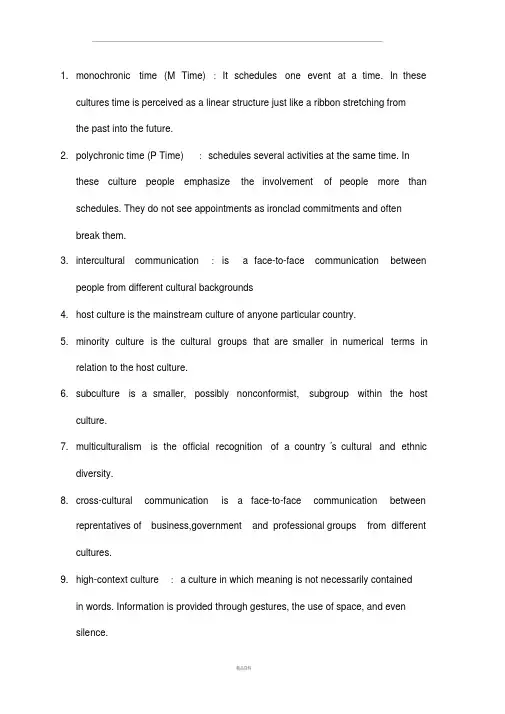
1.monochronic time (M Time) :It schedules one event at a time. In thesecultures time is perceived as a linear structure just like a ribbon stretching fromthe past into the future.2.polychronic time (P Time) :schedules several activities at the same time. Inthese culture people emphasize the involvement of people more than schedules. They do not see appointments as ironclad commitments and oftenbreak them.3.intercultural communication :is a face-to-face communication betweenpeople from different cultural backgrounds4.host culture is the mainstream culture of anyone particular country.5.minority culture is the cultural groups that are smaller in numerical terms inrelation to the host culture.6.subculture is a smaller, possibly nonconformist, subgroup within the hostculture.7.multiculturalism is the official recognition of a country’s cultural and ethnicdiversity.8.cross-cultural communication is a face-to-face communication betweenreprentatives of business,government and professional groups from different cultures.9.high-context culture :a culture in which meaning is not necessarily containedin words. Information is provided through gestures, the use of space, and evensilence.10.low-context culture :a culture in which the majority of the information is vestedin the explicit code.11.perception: in its simplest sense,perception is ,as Marshall singer tells us,”theprocess by which an individual selects, evaluates,and organizes stimuli fromthe external world” In other words, perception is an internal process wherebywe convert the physical energies of the world into meaningful internal experiences.Non-verbal communicationIt refers to communication through a whole variety of different types f signal comeinto play, including the way we more, the gestures we employ, the posture weadopt, the facial expression we wear, the direction of our gaze, to the extent towhich we touch and the distance we stand from each other.. IndividualismIndividualism refers to the doctrine that the interests of the individual are or oughtto be paramount, and that all values, right, and duties originate in individuals. It emphasizes individual initiative, independence,individual expression, and even privacy.13. ParalanguageThe set of nonphonemic properties of speech, such as speaking tempo, vocal pitch, and intonational contours, that can be used to communicate attitudes orother shades of meaning.12.人际交际interpersonal communication: a small number of individuals who are interactingexclusively with one another and who therefore have the ability to adapt their messagesspecifically for those others and to obtain immediate interpretaions from them.指少数人之间的交往他们既能根据对方调整自己的信息,又能立即从对方那里获得解释。
跨文化交际期末考试题【新】
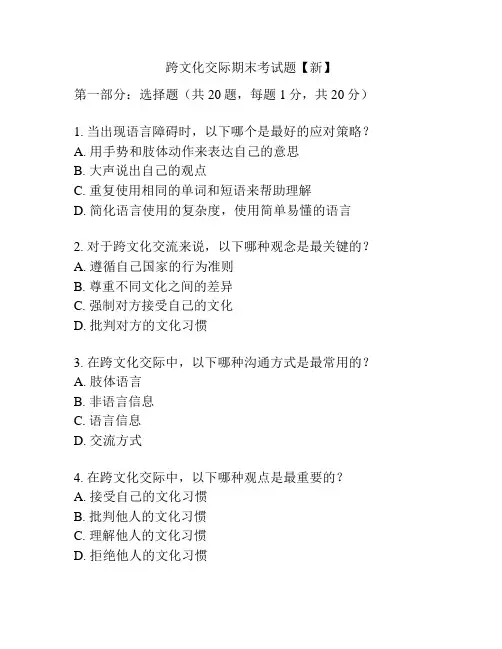
跨文化交际期末考试题【新】第一部分:选择题(共20题,每题1分,共20分)1. 当出现语言障碍时,以下哪个是最好的应对策略?A. 用手势和肢体动作来表达自己的意思B. 大声说出自己的观点C. 重复使用相同的单词和短语来帮助理解D. 简化语言使用的复杂度,使用简单易懂的语言2. 对于跨文化交流来说,以下哪种观念是最关键的?A. 遵循自己国家的行为准则B. 尊重不同文化之间的差异C. 强制对方接受自己的文化D. 批判对方的文化习惯3. 在跨文化交际中,以下哪种沟通方式是最常用的?A. 肢体语言B. 非语言信息C. 语言信息D. 交流方式4. 在跨文化交际中,以下哪种观点是最重要的?A. 接受自己的文化习惯B. 批判他人的文化习惯C. 理解他人的文化习惯D. 拒绝他人的文化习惯5. 在一个跨文化交际的场合中,以下哪个应该是最高的优先级?A. 活跃的参与B. 语言水平的熟练程度C. 适应当地的礼仪和行为准则D. 强调自己的文化背景6. 以下哪个是一个跨文化交际中最常见的问题?A. 礼貌和礼仪的不同B. 文化差异造成的文化霸权C. 认知差异的沟通问题D. 语言障碍7. 以下哪种服务最适合在跨文化交际中使用?A. 机器翻译服务B. 优先选择专业的口译和翻译服务C. 通过朋友或熟人的介绍寻找帮助D. 利用在线社交媒体解决问题8. 在跨文化交际中,以下哪种事情应该避免?A. 尊重并遵循当地的礼仪和行为准则B. 试图改变或批判当地的文化习俗C. 沿用自己的文化行为准则D. 关注当地的文化和语言细节9. 在跨文化交际中,以下哪种技巧是最有用的?A. 避免使用简单易懂的语言B. 直截了当地表达自己的观点C. 关注当地的非语言行为和信号D. 尝试使用当地的单词和短语10. 当尝试与跨文化背景的人交流时,以下哪种能力是最重要的?A. 语言能力B. 理解当地文化的背景C. 思考和行动的方式D. 批判思维11. 在跨文化交际中,以下哪个语言问题最常见?A. 不同的拼写和拼音B. 不同的语法结构和单词含义C. 方言和口音D. 礼仪和交际方式12. 在跨文化交际中,以下哪个观念是最必要的?A. 尊重当地的文化背景B. 认为自己的文化优越C. 轻视当地的命令和指示D. 批判当地文化的错误13. 在跨文化交际中,以下哪个事情是至关重要的?A. 去熟悉当地的文化和语言背景B. 寻找机会批判当地的文化习惯C. 坚持自己的文化行为准则D. 放松身心,自然而然的融入当地环境14. 在跨文化交际中,以下哪种行为应该被避免?A. 尊重他人的文化背景B. 没有认真倾听对方的观点C. 关注当地的语言和文化细节D. 对对方的文化行为进行批评和评价15. 在跨文化交际中,以下哪种观念是最重要的?A. “我们的文化最好”B. “我们的文化最好,但我们也能接受其他文化”C. “所有文化都有其独特之处,值得尊重和理解”D. “其他文化与我们的文化无关”16. 在跨文化交际中,以下哪种行为应该被避免?A. 关注和遵守当地的礼仪和行为准则B. 尝试使用当地的语言和单词C. 尊重和理解当地的文化习俗D. 批判和否定当地的文化习俗17. 在一个跨文化交际的场合中,以下哪个应该是最高的优先级?A. 展示自己的文化背景B. 关注当地的语言和文化细节C. 认真倾听对方的观点D. 强调自己优越的文化背景18. 在跨文化交际中,以下哪种事情应该被避免?A. 尊重所有人的文化背景B. 批判当地的文化行为C. 关注当地的非语言信号D. 使用当地的语言和单词19. 在跨文化交际中,以下哪种技巧是最有用的?A. 尊重当地的文化背景B. 试图改变当地的文化行为准则C. 使用自己的语言和单词D. 关注当地的微妙而又微小的语言和非语言信号20. 在跨文化交际中,以下哪种行为应该被避免?A. 关注当地的礼仪和行为准则B. 忽略当地的迷信和传统信仰C. 尊重当地的宗教和文化背景D. 沿用自己的文化行为准则第二部分:简答题(共5道题,每题4分,共20分)1. 解释什么是文化差异,并列举至少三个文化差异的例子?2. 解释为什么认知差异在跨文化交际中是一个重要的问题,并提供至少三个示例说明不同的认知差异会如何影响跨文化交流?3. 解释什么是非语言沟通,并列举至少三个非语言沟通的例子?4. 解释为什么跨文化交际中的措辞和用词是非常重要的,并提供至少三个示例说明,不同的词语和措辞可能导致文化差异。
跨文化交际复习资料(推荐文档)
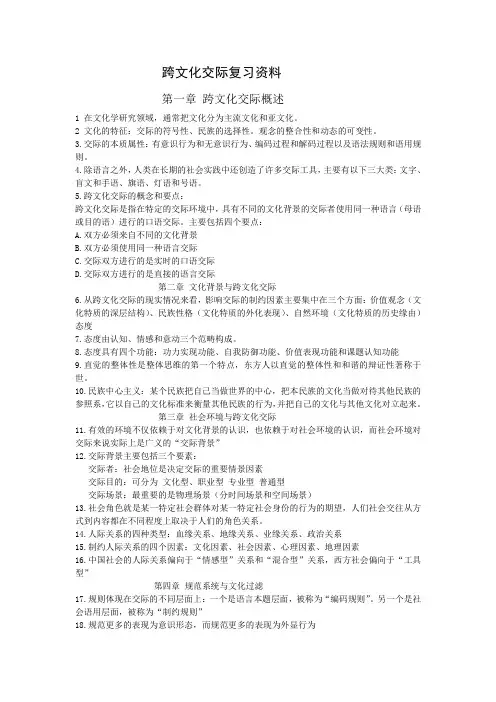
跨文化交际复习资料第一章跨文化交际概述1 在文化学研究领域,通常把文化分为主流文化和亚文化。
2 文化的特征:交际的符号性、民族的选择性。
观念的整合性和动态的可变性。
3.交际的本质属性:有意识行为和无意识行为、编码过程和解码过程以及语法规则和语用规则。
4.除语言之外,人类在长期的社会实践中还创造了许多交际工具,主要有以下三大类:文字、盲文和手语、旗语、灯语和号语。
5.跨文化交际的概念和要点:跨文化交际是指在特定的交际环境中,具有不同的文化背景的交际者使用同一种语言(母语或目的语)进行的口语交际。
主要包括四个要点:A.双方必须来自不同的文化背景B.双方必须使用同一种语言交际C.交际双方进行的是实时的口语交际D.交际双方进行的是直接的语言交际第二章文化背景与跨文化交际6.从跨文化交际的现实情况来看,影响交际的制约因素主要集中在三个方面:价值观念(文化特质的深层结构)、民族性格(文化特质的外化表现)、自然环境(文化特质的历史缘由)态度7.态度由认知、情感和意动三个范畴构成。
8.态度具有四个功能:功力实现功能、自我防御功能、价值表现功能和课题认知功能9.直觉的整体性是整体思维的第一个特点,东方人以直觉的整体性和和谐的辩证性著称于世。
10.民族中心主义:某个民族把自己当做世界的中心,把本民族的文化当做对待其他民族的参照系,它以自己的文化标准来衡量其他民族的行为,并把自己的文化与其他文化对立起来。
第三章社会环境与跨文化交际11.有效的环境不仅依赖于对文化背景的认识,也依赖于对社会环境的认识,而社会环境对交际来说实际上是广义的“交际背景”12.交际背景主要包括三个要素:交际者:社会地位是决定交际的重要情景因素交际目的:可分为文化型、职业型专业型普通型交际场景:最重要的是物理场景(分时间场景和空间场景)13.社会角色就是某一特定社会群体对某一特定社会身份的行为的期望,人们社会交往从方式到内容都在不同程度上取决于人们的角色关系。
最新跨文化交际-期末复习资料-重点笔记
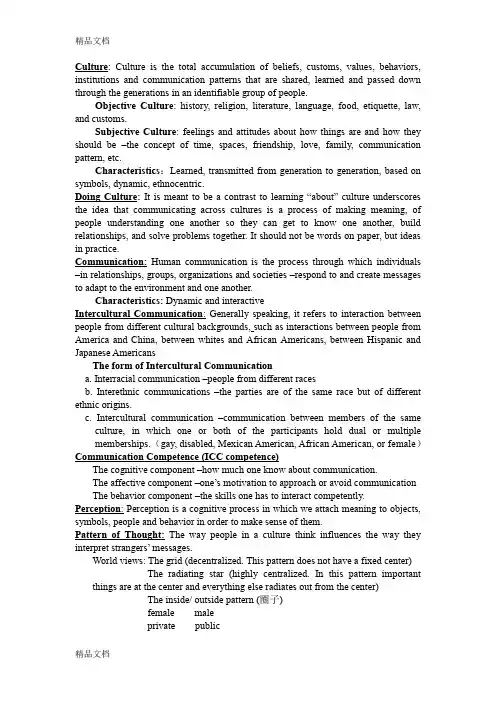
Culture: Culture is the total accumulation of beliefs, customs, values, behaviors, institutions and communication patterns that are shared, learned and passed down through the generations in an identifiable group of people.Objective Culture: history, religion, literature, language, food, etiquette, law, and customs.Subjective Culture: feelings and attitudes about how things are and how they should be –the concept of time, spaces, friendship, love, family, communication pattern, etc.Characteristics:Learned, transmitted from generation to generation, based on symbols, dynamic, ethnocentric.Doing Culture: It is meant to be a contrast to learning “about” culture underscores the idea that communicating across cultures is a process of making meaning, of people understanding one another so they can get to know one another, build relationships, and solve problems together. It should not be words on paper, but ideas in practice.Communication: Human communication is the process through which individuals –in relationships, groups, organizations and societies –respond to and create messages to adapt to the environment and one another.Characteristics: Dynamic and interactiveIntercultural Communication: Generally speaking, it refers to interaction between people from different cultural backgrounds, such as interactions between people from America and China, between whites and African Americans, between Hispanic and Japanese AmericansThe form of Intercultural Communicationa. Interracial communication –people from different racesb. Interethnic communications –the parties are of the same race but of different ethnic origins.c. Intercultural communication –communication between members of the sameculture, in which one or both of the participants hold dual or multiple memberships.(gay, disabled, Mexican American, African American, or female)Communication Competence (ICC competence)The cognitive component –how much one know about communication.The affective component –one’s motivation to approach or avoid communication The behavior component –the skills one has to interact competently. Perception: Perception is a cognitive process in which we attach meaning to objects, symbols, people and behavior in order to make sense of them.Pattern of Thought: The way people in a culture think influences the way they interpret strangers’ messages.World views: The grid (decentralized. This pattern does not have a fixed center) The radiating star (highly centralized. In this pattern important things are at the center and everything else radiates out from the center)The inside/ outside pattern (圈子)female maleprivate publichome market, mosque, coffee housethe outside is plain, not welcoming, even forbidding. The walls are thick to protect what is inside.highly centralized pattern: important people sit in the front middle;decentralized pattern: people sit equally.Stereotyping: People generalize to make sense of his experience. The result of the process of over generalizing based on limited or inaccurate information.The classification of stereotypes1. Negative stereotype of other cultures: Prejudice (severe prejudice)2. Positive stereotype of one’s own culture: Cultural superiority Characteristics: universal, unavoidable, stable, variable, ethnocentrismHigh context communication & Low context communicationHC culture (察言观色): Relies mainly on the physical context or the relationship for information, with little explicitly encoded.LC culture: provide most of the information in the explicit code itself.Perception: Perception is a cognitive process in which we attach meaning to objects, symbols, people and behavior in order to make sense of them.High contact and low contact culture:In high contact cultures people want to get close enough to one another and to objects to sense them in these ways.People in these countries stand closer, touch more, engage in more eye contact and speak more loudly than people do in lower-contact cultures.In a low contact cultures, people rely more on sight, and especially sight at a far distance. People are most likely to stand a certain distance away to get the whole picture, without actually feeling or sensing the other person’s body heat or subtle smell. So in low contact culture as America, one is taught not to breathe on people.However, this visual space seems unfriendly and indifferent to those from high contact cultures, which favor tactile space.When a person from a high contact culture goes to a low contact culture, he or she is likely to feel that people are cold, lack human warmth, and are indifferent and pay no attention to them.low-contact: Asia ; moderate-contact: Australia, Northern Europe, United States high-contact: South America, Mediterranean, the Arab worldLarge and smell Power Distancespower distance is an attempt to measure cultural attitudes about inequality insocial relationships.In high power distance cultures, position in a hierarchy is considered to benatural and important. People are expected to show only positive emotions toothers with high status and to display negative emotions to those with low status;tend to decrease gaze in the presence of powerful people.Low Power Distance Culture: Minimize and eliminate the differences in power and status; more emotional display, increase the amount of gaze. People believe that the differences in power between boss and workers should be reduced and not mphasized.Individualism VS CollectivismThe individualism index measures the extent to which the interests of the individual are considered to be more important than the interests of the group. People from individualist cultures are more likely to act on principles that apply to everyone, principles that are universal and apply to associates and strangers alike. Collectivists are not unprincipled, but when making decisions they tend to give a higher priority to relationships than individualists do. They expect people who are involved in a group relationship to have duties and obligations to one another. Masculinity (Toughness) VS Femininity (Tenderness)Masculinity means everyone in society embraces values that have traditionally been associated with men, that is assertiveness, competitiveness and toughness. On the feminine side of the scale we find societies in which people generally embrace values that have traditionally been labeled as feminine, that is modesty, cooperation and tenderness.Strong and weak Uncertainty AvoidanceThe Uncertainty Avoidance Index seeks to measure the extent to which people in a particular society are able to tolerate the unknowns of life. In high uncertainty avoidance countries people experience more stress and a sense of urgency as they go through their daily routines. Relationships are guided by strict rules. People from low uncertainly avoidance countries do not have a strong need to control things, people, and events by clearly defining and categorizing them. Relationships are guided by strict rules.Intercultural CommunicationIntercultural CommunicationGenerally speaking, it refers to interaction between people from different cultural backgrounds, such as interactions between people from America and China, between whites and African Americans, between Hispanic and Japanese Americans The form of Intercultural Communicationa. Interracial communication –people from different racesb. Interethnic communications –the parties are of the same race but of different ethnic origins.c. Intracultural communication –communication between members of the sameculture, in which one or both of the participants hold dual or multiple memberships.(gay, disabled, Mexican American, African American, or female)Language&CulturePeople pay attention to basic language in cross-culture communication because of the essential role these codes play in communication and they are part of object culture. The same word may stir up different associations in people under different cultural background, e.g. the word “dog”. In eastern culture, dogs are dirty, brutal and stupid. But in western culture, dogs are lovely, loyal and obedient. They are faithful friends and compassionate animals.Language reflects culture. Language expresses cultural reality, reflects the people’s attitudes, beliefs, world outlooks, etc. For example, American businessmen often encode their meanings in metaphors and images from these sports.Chinese traditional sport culture emphasizes the harmony between human beings and oneness between man and nature. It is morality, benevolence, entertainment and longevity. But western sports culture is competition and sportsmanship.Culture shock: Troublesome feelings such as depression, loneliness, confusion, inadequacy, hostility, frustration, and tension, caused by the loss of familiar cues from the home culture.U-Curuemodel:Excitement→Confusion→Frustration→Effectiveness→Appreciation。
跨文化交际课程期末考试资料
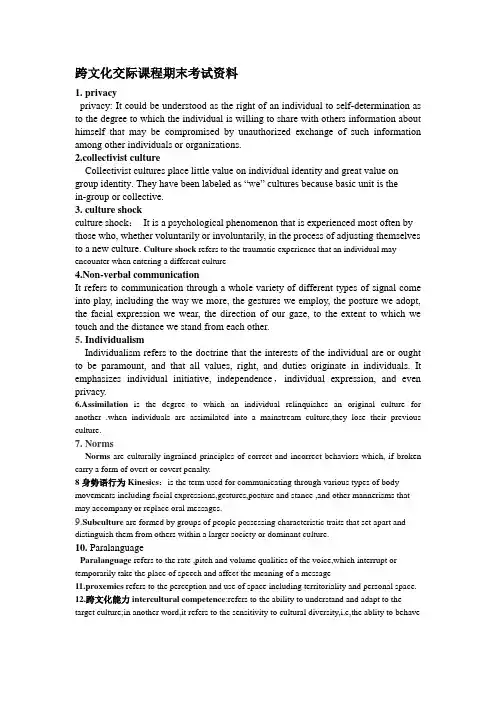
跨文化交际课程期末考试资料1. privacyprivacy: It could be understood as the right of an individual to self-determination as to the degree to which the individual is willing to share with others information about himself that may be compromised by unauthorized exchange of such information among other individuals or organizations.2.collectivist cultureCollectivist cultures place little value on individual identity and great value on group identity. They have been labeled as “we” cultures because basic unit is thein-group or collective.3. culture shockculture shock:It is a psychological phenomenon that is experienced most often by those who, whether voluntarily or involuntarily, in the process of adjusting themselves to a new culture. Culture shock refers to the traumatic experience that an individual may encounter when entering a different culture4.Non-verbal communicationIt refers to communication through a whole variety of different types of signal come into play, including the way we more, the gestures we employ, the posture we adopt, the facial expression we wear, the direction of our gaze, to the extent to which we touch and the distance we stand from each other.5. IndividualismIndividualism refers to the doctrine that the interests of the individual are or ought to be paramount, and that all values, right, and duties originate in individuals. It emphasizes individual initiative, independence,individual expression, and even privacy.6.Assimilation is the degree to which an individual relinquishes an original culture for another .when individuals are assimilated into a mainstream culture,they lose their previous culture.7. NormsNorms are culturally ingrained principles of correct and incorrect behaviors which, if broken carry a form of overt or covert penalty.8身势语行为Kinesics:is the term used for communicating through various types of body movements including facial expressions,gestures,posture and stance ,and other mannerisms that may accompany or replace oral messages.9.Subculture are formed by groups of people possessing characteristic traits that set apart and distinguish them from others within a larger society or dominant culture.10. ParalanguageParalanguage refers to the rate ,pitch and volume qualities of the voice,which interrupt or temporarily take the place of speech and affect the meaning of a message11.proxemics refers to the perception and use of space including territoriality and personal space.12.跨文化能力intercultural competence:refers to the ability to understand and adapt to the target culture;in another word,it refers to the sensitivity to cultural diversity,i.e,the ablity to behavein an appropriate way and to regulate one’s communication and interaction according to the context13.uncertainty avoidance deals with a society’s tolerance for uncertainty and ambiguity ;it ultimately refers to man’s search for truth.是关于一个社会对不确定性和模棱两可的容忍程度。
跨文化交际课程期末考试资料
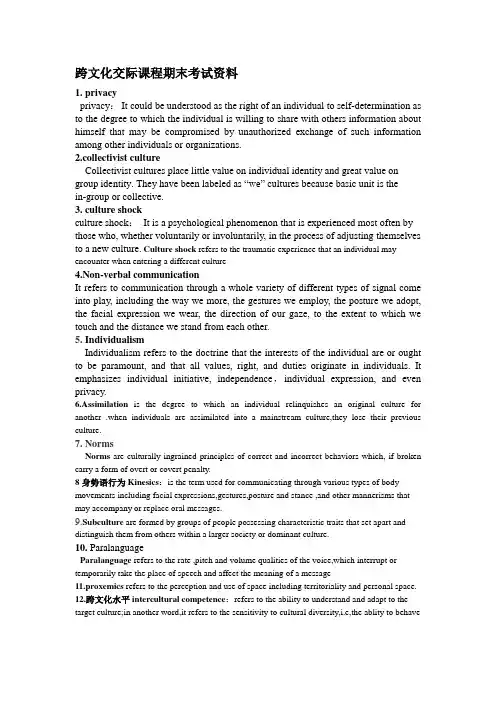
跨文化交际课程期末考试资料1. privacyprivacy:It could be understood as the right of an individual to self-determination as to the degree to which the individual is willing to share with others information about himself that may be compromised by unauthorized exchange of such information among other individuals or organizations.2.collectivist cultureCollectivist cultures place little value on individual identity and great value on group identity. They have been labeled as “we” cultures because basic unit is thein-group or collective.3. culture shockculture shock:It is a psychological phenomenon that is experienced most often by those who, whether voluntarily or involuntarily, in the process of adjusting themselves to a new culture. Culture shock refers to the traumatic experience that an individual may encounter when entering a different culture4.Non-verbal communicationIt refers to communication through a whole variety of different types of signal come into play, including the way we more, the gestures we employ, the posture we adopt, the facial expression we wear, the direction of our gaze, to the extent to which we touch and the distance we stand from each other.5. IndividualismIndividualism refers to the doctrine that the interests of the individual are or ought to be paramount, and that all values, right, and duties originate in individuals. It emphasizes individual initiative, independence,individual expression, and even privacy.6.Assimilation is the degree to which an individual relinquishes an original culture for another .when individuals are assimilated into a mainstream culture,they lose their previous culture.7. NormsNorms are culturally ingrained principles of correct and incorrect behaviors which, if broken carry a form of overt or covert penalty.8身势语行为Kinesics:is the term used for communicating through various types of body movements including facial expressions,gestures,posture and stance ,and other mannerisms that may accompany or replace oral messages.9.Subculture are formed by groups of people possessing characteristic traits that set apart and distinguish them from others within a larger society or dominant culture.10. ParalanguageParalanguage refers to the rate ,pitch and volume qualities of the voice,which interrupt or temporarily take the place of speech and affect the meaning of a message11.proxemics refers to the perception and use of space including territoriality and personal space.12.跨文化水平intercultural competence:refers to the ability to understand and adapt to the target culture;in another word,it refers to the sensitivity to cultural diversity,i.e,the ablity to behavein an appropriate way and to regulate one’s communication and interaction according to the context13.uncertainty avoidance deals with a society’s tolerance for uncertainty and ambiguity ;it ultimately refers to man’s search for truth.是关于一个社会对不确定性和模棱两可的容忍水准。
跨文化交际复习资料
第一章跨文化交际交际:往来应酬跨文化交际:具有不同文化背景的人从事交际的过程第二章文化的定义与特性1.文化的定义:1)人类在社会历史发展过程中所创造的物质和精神财富的总和2)考古学用语,指同一历史时期的不依分布地点为转移的遗迹、遗物的综合体。
3)所谓文化和文明乃是包括知识、信仰、艺术、道德、法律、习俗以及包括社会成员的个人而获得的其他任何能力、习惯在内的一种综合体。
4)历史上创造的所有的生活样式,包括显型的和隐型的,包括合理的、不合理的以及谈不上是合理的或是不合理的一切,他们在某一时期作为人们的潜在指南而存在。
2.文化的特性1)文化是人类所独有的,是区分人类和动物的主要标志。
文化是社会遗产,而不是生理的遗传。
2)文化不是先天所有,而是通过后天习得的。
3)文化中的大部分是不自觉的。
4)文化是人们行动的指南。
5)文化是动态的,文化的形态与一定的历史时期相联系。
第五章语言交际1.语言与文化的关系语言与文化有着密切的关系。
由于语言的产生和发展,人类文化才得以产生和传承。
文化影响语言,使语言为了适应文化发展变化的需要而变得更加精确而缜密。
语言既是文化的载体,又是文化的写照。
2.词义与文化1)语言要素:语音、语法、词汇语音与文化关系最不密切,语法次之,而关系最密切关系最直接的是词汇。
2)有的学者将词汇分为一般词汇和文化词汇(判断区分两种词汇)3.语用规则与文化1)语用规则语用规则就是讲话规则,指根据一定的交际对象、交际场合、交际目的等,对言语形式进行正确选择的规则,是语言的外部规则。
2)语用原则[1]会话合作原则量的准则质的准则相关准则方式准则[2]会话礼貌原则得体准则慷慨准则赞誉准则谦逊准则一致准则同情准则第六章非语言交际1.非语言交际,包括在交际的环境中人为的和环境产生的对于传播者和受传者含有潜在信息的所有的刺激。
2.体态语,是非语言交际的重要组成成分。
3.非语言交际还包括副语言、对时间与空间的利用、味道、颜色等。
跨文化交际期末复习资料知识点总结详细
Intercultural communication in English1. Globalization (what & why)1)Dictionary: to organize or establish worldwide2)Wiki: Globalization refers to the increasingly global relationships of culture, people andeconomic activity.3)Globalization refers to the establishment of a world economy, in which national borders arebecoming less and less important as transnational corporations, existing everywhere and nowhere, do business in a global market.4)Globalization refers to “time-spaces compression”. That is, the way in which the worldappears to be getting smaller. (Reasons: the increasing global mobility of people; the impact of new electronic media on human communications)5)At the same time, people all over the world are faced with the same environmental issuesthat affect all cultures.6)Global instability stems from clashes between cultures as humankind createscatastrophes(灾难) that are far worse than natural disasters.7)Culture interdependence: people from different cultures attempt to get along with eachother and try to decrease conflicts.Driving force: technology, particularly telecommunications, computers2. Culture1)People who are raised or live in a particular place probably speak the same language, holdmany of the same values, and communicate in similar ways.2)the group of people who share the same ancestry3)commodities or products that are internationally exported and imported4) a particular way to satisfy our human needs. Maslow: physiological, safety, belongingness,esteem, self-actualization5)The coherent learned, shared view of a group of people about life’s concerns that rankswhat is important, furnishes attitudes about what things are appropriate and dictates behavior.6)Culture is coherent, learned, the view of a group of people, ranks what is important,furnishes attitudes2.1 elements of communication1)Context: the interrelated conditions of communication(aspects: physical settings, historical,psychological, culture)2)Participants: the participants in communication play the roles of sender and receiver,sometimes of the messages simultaneously.3)Messages: elements: meanings, symbols, encoding and decoding.4)Channels: a channel is both the route traveled by the message and the means oftransportation.5)Noise: noise is any stimulus, external or internal to the participants, that interferes with thesharing of meaning. They include: external noise, internal noise, semantic noise6)Feedback: some kind of verbal or nonverbal response3. Different lands, different friendships1)European: friendship is quite sharply distinguished from other, more casual relations, and isdifferently related to family life.2)American: a friendship may be superficial, casual, situational or deep and enduring.3)French: F is one to one relationship that demands a keen awareness of the other person’sintellect, temperament and particular interests; friends generally are of the same sex;disagreement and argument are the breath of live; compartmentalized (a man play chess with a friend for years without knowing his political opinion)4)Germany: F is much more articulately a matter of feeling; friends are brought to the family;disagreement on any subject that matters to both is a tragedy.5)English: F is based on shared activity, and are formed outside the family circle.4. Comparing and contrasting culturesFrederick:Human nature orientation; man-nature orientation; time orientation; activity orientation; social orientationKluckhohns and Strodtbeck:Human nature; relationship of man to nature; sense of time; activity; social relationships4.1Cultural dimensions (Geert Hofstede)Individualism versus collectivismUncertainty avoidancePower distanceMasculinity versus femininityLong-term versus short-term orientation5. High & low context culturesAdding: from wikipediaLow context culture and the contrasting "high context culture" are terms presented by the anthropologist Edward T. Hall in his book Beyond Culture. Low context culture refers to a culture’s tendency not to cater towards in-groups. An "in-group" is defined by the authors as being a discrete group having similar experiences and expectations, from which, in turn, inferences are drawn. Low context cultures, such as Germany or the United States make much less extensive use of such similar experiences and expectations to communicate. Much more is explained through words or verbalization, instead of the context.High context culture and the contrasting "low context culture" are terms presented by the anthropologist Edward T. Hall in his 1976 book Beyond Culture. It refers to a culture's tendency to use high context messages over low context messages in routine communication. This choice of communication styles translates into a culture that will cater to in-groups, an in-group being a group that has similar experiences and expectations, from which inferences are drawn. In a high context culture, many things are left unsaid, letting the culture explain. Words and word choice become very important in higher context communication, since a few words can communicate a complex message very effectively to an in-group (but less effectively outside that group), while in a lower context culture, the communicator needs to be much more explicit and the value of a single word is less important.6. How is language related to culture?1)Culture and language are intertwined and shape each other.2)Culture influences language by way of symbols and rules for using those symbols, as well asour perceptions of the universe.3)All languages have social questions and information questions. The meaning comes out ofthe context, the cultural usage.4)Language reflects cultural values.5)Sometimes different cultures use identical words that have rather different meanings. Theresults can be humorous, annoying, or costly, depending on the circumstances.6)Even if two people from different cultures can speak a common language, they maymisinterpret the cultural signals.7)To summarize, in the culture itself, language-and-culture is embedded in cultural products,practices, perspectives, communities, and persons. One reflects the other, and they are best seem as joined. Language , as a product of culture, is infused with culture.7. The sapir-whort hypothesis8. Nonverbal communication (what)Nonverbal communication is usually understood as the process of communication through sending and receiving wordless,(mostly visual) messages between people. Messages can be communicated through gestures and touch, by body language or posture, by facial expression and eye contact. Nonverbal messages could also be communicated through material exponential; meaning, objects or artifacts (such as clothing, hairstyles or architecture). Speech contains nonverbal elements known as paralanguage, including voice quality, rate, pitch, volume, and speaking style, as well prosodic features such as rhythm, intonation, and stress. Likewise, written texts have nonverbal elements such as handwriting style, spatial arrangement of words, or the physical layout of a page. However, much of the study of nonverbal communication has focused on face-to-face interaction, where it can be classified into three principal areas: environmental conditions where communication takes place, physical characteristics of the communicators, and behaviors of communicators during interaction.I.e. voices, handshakes, hand gestures, eyes movement, face expressions (smile, laugh),touching behaviorIt is governed by culture.Functions: repeating, complementing, substituting, regulating, and contradicting.9. Social timethe peculiarities of the Past-Present-Future in social processes, and their unbreakable connection.10. Improving intercultural communication1)To begin with your own culture, regardless of what that culture might be.2)To identify those attitudes, prejudices, and opinions that we all carry around and that biasthe way the world appears to us.3)To learn to recognize your communication style.Advices:1)Both parties involved in intercultural communication should seek a common language andattempt to understand cultural differences in using the language.2)To develop empathy - be able to see things from the point of view of others so that we canbetter know and adjust to the other people.3)To be flexible when deciding on how to present yourself to another person.。
跨文化交际复习资料
第一章跨文化交际概述第一节文化、交际和语言1.“文化”的定义这个概念的内涵、外延差异很大,所以文化有广义和狭义之分。
①广义文化的内部结构包括物态文化、制度文化、行为文化、心态文化四个层次。
物态文化层是人类的物质生产活动方式和产品的总和,是可触知的具有物质实体的文化事物。
饮食、服饰、建筑、交通、生产工具以及乡村、城市等。
制度文化层是人类在社会实践中组建的各种社会行为规范构成,行为文化层是人际交往中约定俗成的以礼俗、民俗、风俗等形态表现出来的行为模式。
以民风民俗形态出现,见之于日常起居动作之中,具有鲜明的民族、地域特色。
心态文化是人类在社会意识活动中孕育出来的价值观念、审美情趣、思维方式等主观因素,②狭义文化指意识形态所创造的精神财富,包括宗教、信仰、风俗习惯、道德情操、学术思想、文学艺术、科学技术、各种制度等。
专注于精神创造活动,所以又被称作“小文化”。
2.定势(文化定势)的定义、分类及成因(1)定义:定势指不同社会群体“在人们头脑中的形象。
定势概念应用到跨文化交际上后,称为文化定势。
文化定势指人们在跨文化交际研究或跨文化实际交往中对不同文化背景的民族和国家成员的笼统的,简单的看法,或指一个群体对另一群体成员按某种先入为主的标准或尺度的概括的、形象化的认知。
这些标准或尺度带有较大的主观性,是一种思维方式,一种无视群体内部存在差异、无视普遍性还存在特殊性的思维方式。
(2)分类文化定势可分为“自定势”和“他定势”两类。
前者是指某一个社会和文化群体对本群体共同认可的价值和行为特征普遍性、概括性的表述,这些价值在跨文化交际研究中也常常被称为“自我图像”。
本群体成员往往会不加反思地对这些价值观和行为特征做出简单的认同。
后者是指某一社会和文化群体对另一社会和文化群体的价值观和行为特征的共同认定,也常常被称作“他者图像”。
(3)成因社会和个体。
从孩子出生开始便不断经历着各种各样的教育。
家庭教育,孩子关于世界的认知里就自然而然地打上了父母文化定势的烙印。
《跨文化交际》复习材料
《跨文化交际》复习材料跨文化交际是在不同文化背景下进行有效沟通和交流的能力和技巧。
随着全球化的发展,跨文化交际能力变得越来越重要。
下面是一些跨文化交际的复习材料,供参考。
一、了解跨文化交际的基本概念1.跨文化交际的定义和重要性-跨文化交际是指在不同文化背景下进行有效沟通和交往的过程。
-跨文化交际能力是现代社会中不可或缺的一项重要能力,对于成功开展国际业务、扩大国际影响力等都具有很大的意义。
2.跨文化交际的特点和挑战-文化差异:不同国家、地区的文化差异会影响人们的行为习惯、价值观念等方面。
-语言障碍:不同语言的存在会给跨文化交际带来困难。
-礼仪和习俗:不同国家有各自的礼仪和习俗,不同的行为方式可能会因为文化差异而引起误解。
二、了解不同文化的差异和特点1.文化的定义和特点-文化是指一定时期和地区内人们的集体创造的一种总体性且复杂的社会文明现象。
-文化具有包括价值观念、思维方式、行为习惯等在内的多个方面。
2.不同文化的差异和特点-价值观念:不同文化对价值观念的看法和重视程度存在差异。
-社会习俗:不同文化在社会交往、庆祝活动等方面的习俗也存在较大差异。
-沟通方式:不同文化在沟通方式、语言使用等方面也会出现差异。
-时间观念:不同文化对时间观念的重视程度存在较大差异。
三、学习有效的跨文化交际技巧1.尊重对方文化-学习关于对方文化的基本知识,尊重对方的价值观念和习俗。
-避免对对方文化的偏见和刻板印象,保持开放的心态。
2.提升跨文化沟通能力-学习对方语言,尽量使用对方语言进行交流。
-学习不同文化的非语言沟通方式,如手势、面部表情等。
-长辈尊重:在跨文化交际中,尊重长辈是一种常见的礼节。
3.进行有效的文化调适-了解对方文化的特点,根据对方的文化习俗和行为准则进行调适。
-注意语言和行为的表达方式,避免因文化差异造成的误解。
4.增加跨文化交际的意识-了解跨文化交际的重要性,积极寻求跨文化交流的机会。
-提高自身的文化敏感度,增加对不同文化的了解和尊重。
- 1、下载文档前请自行甄别文档内容的完整性,平台不提供额外的编辑、内容补充、找答案等附加服务。
- 2、"仅部分预览"的文档,不可在线预览部分如存在完整性等问题,可反馈申请退款(可完整预览的文档不适用该条件!)。
- 3、如文档侵犯您的权益,请联系客服反馈,我们会尽快为您处理(人工客服工作时间:9:00-18:30)。
1.Iceberg:{Edward. 7. Hall.--<The silence of language>标志着“跨文化交流”学科的开始} Culture can be viewed as an iceberg. Nine-tenths of an iceberg is out of sight (below the water line). Likewise, nine-tenths of culture is outside of conscious awareness. The part of the cultural iceberg that above the water is easy to be noticed. The out-of-awareness part is sometimes called “deep culture”. This part of the cultural iceberg is hidden below the water and is thus below the level of consciousness. People learn this part of culture through imitating models. / Above the water: what to eat, how to dress, how to keep healthy;Below the water: belief, values, worldview and lifeview, moral emotion, attitude personalty2.Stereotype:定型主义 a stereotype is a fixed notion about persons in a certain category, with no distinctions made among individuals. In other words, it is an overgeneralized and oversimplified belief we use to categorize a group of people.3.Ethnocentrism: 民族中心主义Ethnocentrism is the technical name for the view of things in which one’s own group is the center of everything, and all others are scaled and rated with reference to it. It refers to our tendency to identify with our in-group and to evaluate out-groups and their members according to its standard.4.Culture:Culture can be defined as the coherent, learned, shared view of group of people about life’s concerns that ranks what is important, furnishes attitudes about what things are appropriate, and dictates behavior.5.Cultural values: Values inform a member of a culture about what is good and bad, right and wrong, true and false, positive and negative, and the like. Cultural values defines what is worth dying for, what is worth protecting, what frightens people, what are proper subjects for study and for ridicule, and what types of events lead individuals to group solidarity.6.Worldview: A worldview is a culture’s orientation toward such things as God, nature, life, death, the universe, and other philosophical issues that are concerned with the meaning of life and with “being”.7.Social Organizations: The manner in which a culture organizes itself is directly related to the institution within that culture. The families who raise you and the goverments with which you associate and hold allegiance to all help determine hoe you perceive the world and how you behave within that world.8.Globalization: refers to the establishment of a world economy, in which national borders are becoming less and less important as transnational corporations, existing everywhere and nowhere, do business in a global market.munication: Communication is any behavior that is perceived by others. So it can be verbal and nonverbal, informative or persuasive, frightening or amusing, clear or unclear, purposeful or accidental, communication is our link to the rest of the humanity. It pervades everything we do.10.Elements of communication process:交流过程的基本原理(1).context: The interrelated conditions of communication make up what is known as context.(2).The participants: in communication play the roles of sender and receiver, sometimes—as in face-to-face communication—of the messages simultaneously.(3). messages: are far more complex. They include the elements of meanings, symbols, encoding and decoding.(4). A channels: is both the route traveled by the messages and the means of transportation. We may use sound, sight, smell, taste, touch, or any combination of these to carry a message.(5). noise: is any stimulus, external or internal to the participants, that interferes with the sharing of meaning. External noise: sight, sound…Internal noise: thoughts, feeling…Semantic noise: unintended meaning aroused by certain verbal symbols can inhibit the accuracy of decoding.(6).Feedback: As receivers attempt to decode the meaning of messages, they are likely to give some kind of verbal or nonverbal response. This response, called feedback, tells the sender whether the massage has been heard, seen, or understood.11.Abraham Mslow (亚伯拉罕•马斯洛) –five basic needs五个需求1. physiological needs—food, water, air, rest, clothing, shelter, and all necessary to sustain life2. safety needs—physically safe, psychologically secure3. belongingness needs—accepted by other people and needs to belong to a group or groups.4. esteem needs—recognition, respect, reputation5. self-actualization needs-the highest need of a person12.Culture Dimensions 文化维度13.A High-context: 内向型communication or message is one in which most of the information is either in the context or internalized in the person, while very little is in the context or internalized in the person, while very little is in the coded, explicit, transmitted part of the message. Eg. Japanese, Chinese, Korean, African American, Native American. self-effacement隐匿自我A Low-context:外向型communication is just the opposite, the mass of the information is vested in the explicit code, and the context or situation plays a minimal role. Eg. German-Swiss, German, Scandinavian, American, French, English self-enhancement凸显自我Low-context interaction emphasizes direct talk, person-oriented focus, self-enhancement mode, and the importance of “talk”. High-context interaction, in comparison, stresses indirect talk, status-oriented focus, self-effacement mode, and the importance of nonverbal signals and even silence.Eg: In Scene 1 and spell out everything that is on their minds with no restraints. Their interactionexchange is direct,to the point, bluntly contentious, and full of face-threat verbal message. Scene 1 represents one possible low-context way of approaching interpersonal conflict.In Scene 2, has not directly expressed her concern over the piano noise with because she wants to preserve face and her relationship with . Rather, only uses indirect hints and nonverbal signals to get her point across. However, correctly “reads between the lines” of verbal message and apologizes appropriately and effectively before a real conflict can bubble to surface. Scene 2 represents one possible high-context way of approaching interpersonal conflict.Direct and Indirect Verbal Interaction Styles self-enhancement and self-effacement凸显自我,隐匿自我In the direct verbal style, statements clearly reveal the speaker’s intentions and are enunciated in a forthright tone of voice. In the indi rect verbal style, verbal statements tend to camouflage the speaker’s actual intentions and are carried out with more nuanced tone of voice.14.Colors: Black: death, evil, mourning, sexy; Blue-cold, sad, sky, masculine; Green-envy, greed, money; Pink: feminine, shy, softness, sweet; Red: anger, hot, love, sex; White: good, innocent, peaceful, pure; Yellow: caution, happy, sunshine, warm15.Functions of Nonverbal Communication: repeating, complementing, substituting, regulating contradicting16.Confucian teaching key principles: 1.Social order and stability are based on unequal relationships between people. 2. The family is the prototype for all social relationships. 3. Proper social behavior consist of not treating others as you would not like to be treated yourself. 4. People should be skilled , educated, hardworking, thrifty, modest, patient, and persevering.Four books and five classical: The Analects of Confucian <论语>, Mencius <孟子>,Great Learning <大学>,The Doctrines of Mean <中庸> / Classic of poetry <诗经>,Book of documents <尚书>, Book of kites <礼记>, Classic of changes <周易>, Spring and Autumn Annals <春秋>. 仁义礼智信:merciful, justified, polite, intelligent, honest17.The Sapir-Whorf Hypothesis: language becomes our shaper of ideas rather than simple our tool for reporting ideas, language influenced or even determined the ways in which people thought. The central idea of the Sapir-Whorf hypothesis is that language functions, not simply as a device for reporting experience, but also, and more significantly, as a way of defining experience for its speakerInfluence: The Sapir-Whorf hypothesis has alerted people to the fact language is keyed to the total culture, and that it reve als a people’s view of its total environment. Language directs the perceptions of its speakers to certain things; it gives them ways to analyze and to categorize experience. Such perceptions are unconscious and outside the control of the speaker. The ultimate value of the Sapir-Whorf hypothesis is that it offers hints to cultural differences and similarities among people.18.The way people speakHigh involvement高度卷入: 1. talk more 2. interrupt more 3. expect to be interrupted 4. talk more loudly at times 5. talk more quickly. Eg. Russian, Italian, Greek, Spanish, South American, Arab, AfricanHigh considerateness高度体谅: 1, speak one at a time 2. use polite listening sounds, 3. refrain from interrupting, 4. give plenty of positive and respectful responses to their conversation partners. Eg. Mainstream American19.文化维度Orientation—Kluckhohns and Strodtbeck Beliefs and Behaviors20.Chinese VS English-----Chinese: open, visual, old. English: close, changing, modern21.Stumbling Blocks in Intercultural Communication跨文化交际中的绊脚石(1) Assumption of similarities假定相似(2) Language differences (3) Nonverbal misinterpretations不用言语表达的误解(4) Preconception先入为主的概念的固定形式(5) Tendency to evaluate评价意图(6) High anxiety焦虑(7) Conclusion22. Essentials of Human Communication(1) Communication is a dynamic process. (2) Communication is symbolic. (3) Communication is systemic.(4) Communication involves making inferences. (5) Communication has a consequence23. How is language related to cultureCulture and language are intertwined and shape each other. In our own environment we aware of the implications of these choices. All languages have social questions and information questions. The point is that words in themselves do not carry the meaning. The meaning comes out of the context the cultural usage. In addition to the environment, language reflects cultural values.24.More words/expression→important role in cultureIn Chinese we have many kinship terms, some of which seem to have no equivalents in English. Compared with Chinese, English has fewer kinship terms. The difference is not just linguistic; it is infundamentally cultural.25.A culture’s conception of time can be examined from three different perspectives: 1. informal time;2. perceptions of past, present, and future;3. monochromic and polychromic.26.Monochronic(M-time) 单维时间and polychromic(P-time)多维时间Monochronic people:美国人Do one thing at a time. Concentrate on the job. Take time commitments seriously. Are committed to the job. Adhere to plans. Are concerned about not disturbing others; follow rules of privacy. Show great respect for private property; seldom borrow or lend. Emphasize promptness. Are accustomed to short-term relationships.Polychromic people: 中国人Do many things at once. Are easily distracted and subject to interruptions. Consider time commitments an objective to be achieved, if possible. Are committed to people and human relationships. Change plans often and easily. Are more concerned with people close to them(family, friend, close business associates) than with privacy. Borrow and lend things often and easily. Base promptness on the relationship. Have strong tendency to build lifetime relationships.27.Adapting to a New Cultureculture shock.: Any number of symptoms征兆can occur during cycles of culture shock. These symptoms can be (1)physiological (2)emotionally (3)communicationPredeparture stage:Stage one: everything is beautiful. Stage two: everything is awful. Stage three: everything is OK.Adaptation and reentry再进入Methods: 1. patience. 2. meet new people. 3. try new things. 4. give yourself periods of rest and thought. 5. work on your self-concept. 6. write. 7. observe body language. 8. learn the verbal language.。
